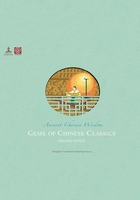
齐民要术 (qí mín yào shù)
China’s First Agricultural Encyclopedia
Agricultural advice takes root in society
Qimin Yaoshu or the “Essential Techniques for the Welfare of the People” was first compiled in the midsixth century and now is widely regarded as China’s first agricultural encyclopedia and the best preserved of all ancient Chinese agricultural texts.
Jia Sixie, author of the agricultural encyclopedia, was a famous agronomist in the Northern Wei Dynasty (386-534 AD).
Jia was born into a scholar’s family that had been farmers for several generations in today’s Shandong Province in eastern China. During his childhood, Jia’s family wasn’t wealthy, but boasted a rich collection of books on agriculture. This provided the young Jia with an opportunity to read extensively ancient Chinese literature on farming, animal husbandry, fishery, forestry and related subjects.
As a result, when he began to write the “Essential Techniques for the Welfare of the People” years later, he was able to quote from more than 160 ancient agriculture books and treatises, including Simin Yueling, or the “Monthly Instructions for Four Classes of People,” one of the oldest agricultural texts in China.
As an adult, Jia was appointed by the imperial court as magistrate of Gaoyang, today’s Linzi in Shandong Province. But later, he returned to his home to concentrate on farming and writing his book on agriculture.
Apart from being conversant with ancient Chinese literature on agriculture, Jia paid great attention to practical experience in farming and rural production. He traveled to many places to observe agricultural production and talk to local farmers to record their methods.
He also tried to accumulate experience in animal husbandry by raising sheep and chickens.
Later, Jia included the practical experience he had collected in the “Essential Techniques for the Welfare of the People,” which he completed around 533-544 AD.
The book contains 10 volumes and 92 chapters in around 110,000 Chinese characters. It comprehensively records the farming techniques, agricultural product processing and storage procedures, horticultural and silk farming methods and animal husbandry and fishery practices of ancient Chinese farmers living along the middle and lower reaches of the Yellow River in northern China.

The author elaborated on the importance of improving farming tools and the positive and negative effects that climate and soil conditions can have on crop production. He proposed methods to increase the fertility of land, such as tilling the top soil, winter irrigation and green manure crops rotation.
Jia advised farmers to sow thickly to boost the specific yield of crops. In addition, he emphasized the importance of seed breeding in cultivating better varieties.
In terms of horticulture, Jia introduced methods of grafting, flower thinning and mixed planting. For instance, he pointed out that planting locust tree saplings along with cannabis would enable the tree saplings to grow straight.
In animal husbandry, Jia prescribed requirements for selecting excellent varieties of farm animals by judging their eyes, mouths, ears, noses, backbones, legs and knees.
The author devoted numerous pages to processing foods and cooking methods, such as brewing, making candied fruit, cooking fish and meat, making preserved meat and baking.
As a result, some scholars say that the “Essential Techniques for the Welfare of the People” can be seen as an ancient Chinese cook book.
The book was regarded as an official guide on Chinese agriculture for more than 1,300 years.
It was translated into several foreign languages and was referenced by Charles Darwin (1809-1882) when the English naturalist was working on his theory of evolution.